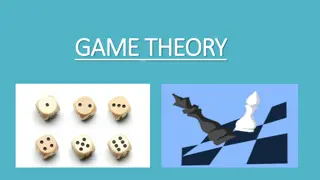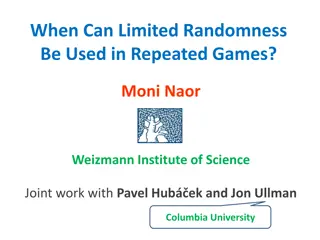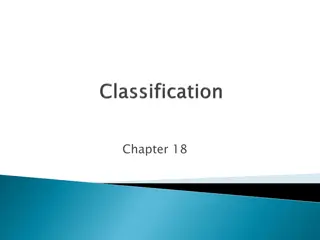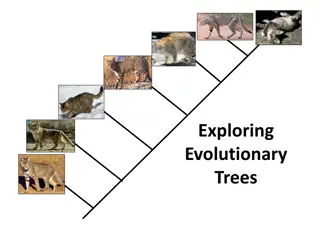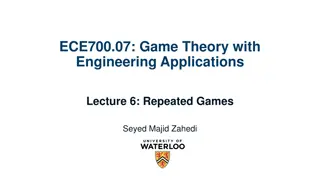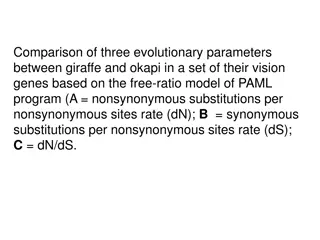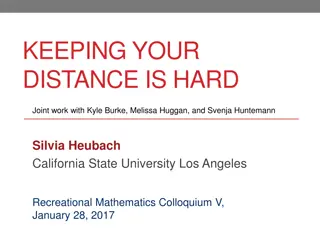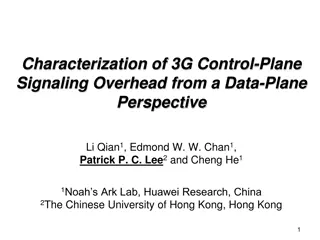Evolutionary Dynamics in Signaling Games and Strategies
Explore the intricate dynamics of signaling games and evolutionary strategies like Lewis signaling games, Hamilton Maynard Smith theories, and replicator dynamics. Witness the evolution of signaling strategies through simulations and understand the role of replicator dynamics in population interactions and co-evolution. Delve into the complexities of sender-receiver interactions and the emergence of stable strategies. Unravel the fascinating nature of signaling games through various examples and their implications in adaptive dynamics.
Uploaded on Sep 11, 2024 | 3 Views
Download Presentation

Please find below an Image/Link to download the presentation.
The content on the website is provided AS IS for your information and personal use only. It may not be sold, licensed, or shared on other websites without obtaining consent from the author.If you encounter any issues during the download, it is possible that the publisher has removed the file from their server.
You are allowed to download the files provided on this website for personal or commercial use, subject to the condition that they are used lawfully. All files are the property of their respective owners.
The content on the website is provided AS IS for your information and personal use only. It may not be sold, licensed, or shared on other websites without obtaining consent from the author.
E N D
Presentation Transcript
Tomorrow- Move to S-120
SIGNALING GAMES: Dynamics and Learning NASSLI 2016 Wednesday
Evolutionary Dynamics of Lewis Signaling Games
Peter Taylor T. & J. Evolutionarily Stable Strategies and Game Dynamics (1978)
Leo Jonker T. & J. Evolutionarily Stable Strategies and Game Dynamics (1978)
Replicator Dynamics 1. Differential Reproduction 1. Differential Imitation Note: qualitative behavior of replicator dynamics may generalize to a wide class of adaptive dynamics.
Replicator Dynamics xi = xi (average fitness si average fitness pop.)
Bargaining Example Orbits: replicator dynamics
A Rock-Scissors-Paper Type Example Orbits: replicator dynamics
The Simplest Lewis Signaling Game Nature flips a fair coin to choose state 1 or 2. Sender observes the state & sends signal A or B. Receiver observes the signal and guesses the state. Correct guess pays off 1 to both; otherwise nothing.
Evolution in the Simplest Signaling Game Replicator Dynamics random encounters 2 populations: Senders; Receivers 1 population: roles
Evolution in the Simplest Signaling Game Replicator Dynamics random encounters 2 populations: Senders; Receivers 1 population: roles Simulations always learn to signal. Why?
Evolution of Signaling: 2 populations (only separating strategies) Sig I Sig II (vector field)
Evolution of Signaling: 1 population (only separating strategies)
Analytic Proof 2 population (Hofbauer and Huttegger (2008) JTB Signaling Systems are attractors. Pooling equilibria are all dynamically unstable. Signaling systems emerge spontaneously from almost every starting point.
A result almost too strong to believe. We started by asking whether it is possible for meaning to emerge spontaneously. Here it seems almost necessary for signaling to evolve.
Is this result robust? The model is not structurally stable.
Structural Stability A Dynamics (given by a vector field) is Structurally Unstable if an arbitrarily small change in the vector field yields a qualitatively different dynamics.
Arbitrarily small difference? At each point in the simplex, for each component, there is a numerical difference. Take the maximum. Take the least upper bound of these numbers. This is the distance between the vector fields.
Qualitatively Different? Two vector fields are qualitatively the same, i.e. (topologically equivalent) if there is homeomorphism of the simplex to itself that takes the orbits of one into the orbits of the other (preserving sense of the orbits).
Perturbation 1: States not equiprobable Component of pooling equilibria collapses from a plane to a line. Interior points of this line now stable. Pooling has a positive basin of attraction.
Perturbation 1: States not equiprobable Component of pooling equilibria collapses from a plane to a line. Interior points of this line now stable. Pooling has a positive basin of attraction. -- but this model also is not structurally stable.
Perturbation 2: mutation (or experimentation) Replicator Dynamics replaced by Selection-Mutation dynamics Experimentation rates might be different for receivers, , and for senders, .
Mutation Pooling equilibria collapse to a single point. Is it dynamically unstable, stable, strongly stable? It depends.
Perturbation: mutation Pooling equilibria collapse to a single point. Is it dynamically unstable, stable, strongly stable? It depends on: - the disparity in the probabilities of the states - the relative mutation rates in the two populations (Hofbauer and Huttegger JTB 2008).
Mutation Pooling equilibria collapse to a single point. If mutation rates are equal (and small) a qualitative transition from unstable to stable takes place at about p = .788
Mutation Pooling equilibria collapse to a single point. If mutation rates are equal (and small) a qualitative transition from unstable to stable takes place at about p = .788 but if the receiver is at least twice as likely to mutate as the sender, the point is always unstable.
Mutation Pooling equilibria collapse to a single point. If mutation rates are equal (and small) a qualitative transition from unstable to stable takes place at about p = .788 but if the receiver is at least twice as likely to mutate as the sender, the point is always unstable. Model is structurally stable.
What about 3? 3 states, 3 signals, 3 acts States equiprobable Partial pooling can evolve. States not equiprobable Total pooling can evolve (as before)
What about 3? 3 states, 3 signals, 3 acts Mutation helps, as with 2 by 2 by 2. Analysis is complex. See Hofbauer and Huttegger (2015)
Variation on R-S-P A1 A2 A3 S1 -1, 1 .5, -.5 1, -1 S2 1,-1 -1, 1 .5, -.5 S3 .5, -.5 1,-1 -1, 1
Chaos (structurally stable) x3 x1 x2 Wagner BJPS 2012, Sato Akiyama, Farmer, PNAS 2002.
Mixed Interests with Differential Signaling Costs Cycles also occur here in a non-trivial way in: Spence Signaling Game - Noldeke &Samuelson J. Econ. Th. (1997) - Wagner Games (2013) Sir Philip Sydney Game - Huttegger & Zollman Proc.Roy.Soc.(2010)
Summary: Replicator With common interest, emergence of signaling systems with positive probability is ubiquitous, but with probability 1 only in special circumstances. With opposed interests, equilibrium may not be reached, but rather persistent Red Queen information transmission. In well-known costly signaling games the Red Queen is a real possibility.
II. Finite Population Frequency-Dependent Moran Process With rare mutations
Frequency Dependent Moran Process 1. Everyone plays the base game with everyone else, to establish fitness. 2. One individual leaves to group (dies); a new one walks in the door (is born). The new individual imitates a strategy in the population with probability proportional to its average success. Fudenberg, Imhoff, Nowak, Taylor (2004)
Markov chain where the state is the number of members of the population playing each strategy. Monomorphisms are the unique absorbing states. Add mutation: The new member with some small probability chooses any strategy (including those extinct). Then the Markov chain is ergodic.
Small Mutation Limit Study the proportion of time a population spends in states in the limit, -as mutation rate goes to zero. Fudenberg and Imhof JET (2006) (It suffices to study transition probabilities between monomorphisms, initiated by one mutation.)
A Type of Game - Sender is one of two types, High or Low. - Sender sends one of two signals. (cost-free) - Receiver has two acts, one which she would prefer for the high sender; the other for the low sender. - But Sender would always prefer to be treated as a high type. - The only Nash equilibria are pooling.
Numerical Example Act High 1, 1 1, 0 Act Low 0, 0 .8, 1 State High State Low probability of state 1 (high) = .4. Symmetrize the game population size = 50
Long-run Behavior (from Wagner BJPS 2014)
Related: Costless Pre-play Exchange of Signals -in Stag Hunt -in PD More Signals are better. Santos, Pacheco, Skyrms JTB (2011)
Summary: Replicator With common interest, emergence of signaling systems is guaranteed only in special circumstances. With opposed interests, equilibrium may not be reached, but rather persistent Red Queen information transmission. In well-known costly signaling games the Red Queen is a real possibility.
Summary: Moran Process, Small Mutation Limit A small population may spend most of its time in a signaling system even when pooling is the only Nash equilibrium. Pre-play signaling can lead to high levels of cooperation in Stag Hunt, and even in PD.
Selection-Mutation Dynamics Hofbauer (1985) J. Math. Bio.
Selection-mutation dynamics Pooling equilibria collapse to a single point. Is it dynamically unstable, stable, strongly stable? It depends. (Hofbauer and Huttegger JTB 2008). If a sink, otherwise a saddle. (for small mutation rates).







